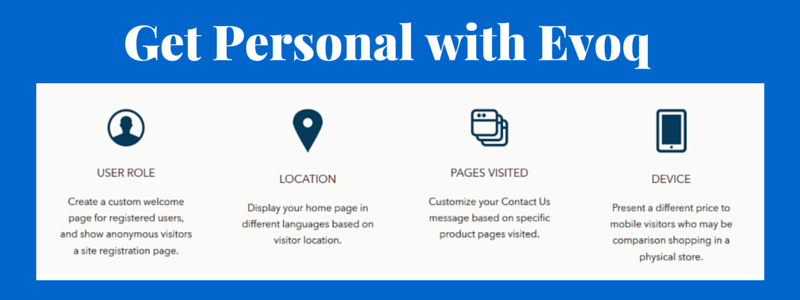
When I first started using LinkedIn, I’d see the list of “People You May Know.” It always amazed me. How were they able to suggest all these people I know, but have not connected with on LinkedIn?
They looked at information about me (i.e. whom I’m connected to) and used algorithms to predict whom I'd want to connect with. Because of recommendations like this, I began to expect web experiences that are personalized to my tastes, preferences and desires.
But like the LinkedIn example, “personalization” needs to be far more than the “Dear Chris” that begins most marketing emails. It’s great that you know my first name, but I expect you to know more. I want you to combine profile information with activity data to understand me the way LinkedIn does.
In this post, I’ll provide five use cases for
Evoq’s content personalization. As you’ll see, Evoq provides an easy-to-use, drag-and-drop user interface to create personalization rules and personalized pages. It gives you the opportunity to delight your visitors the same way LinkedIn delighted me.
Benefits of Content Personalization
First, let’s touch on the benefits of content personalization for B2B websites.
Content personalization is seen as an essential digital marketing capability that increases conversion, according to recent research by
Econsultancy.
While conversion may be an end goal, personalization can also help you improve related website metrics, such as time on site, time on page and pages per visit. Personalization helps you “hit the mark” with visitors and when that happens, they’ll visit more pages and stay on your site longer.
Now, let’s take a look at five use cases for Evoq’s content personalization.
Use Case 1: Make a Special Offer to Existing Customers
For members of your site, Evoq has a way of organizing them into “user roles.” Permissions and workflow in Evoq are based on user role. Users can have one or more user roles assigned to them. Permissions, then, are associated with a user role and apply to all users within that role.
For instance, the “Marketing” user role may have permissions to edit all sections of the site, whereas the “Human Resources” user role may have permissions to update just the “Careers” section. What many of our clients do is segment their customers based on user role.
You can create a user role per product, then assign the appropriate roles to each customer, based on the products they purchased. With Evoq’s content personalization, you can now present customers with special offers that non-customers do not see.
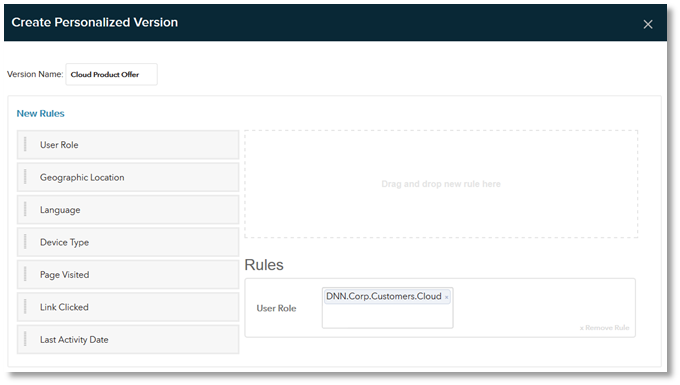
In the example here (“Cloud Product Offer”), we have a user role on dnnsoftware.com for our
Evoq OnDemand (cloud) customers. Let’s say we wanted to create special offers to our cloud customers while they’re visiting the Evoq OnDemand page. We’d drag over the “User Role” attribute, then select the role for our cloud customers. From there, we’d build a personalized version of the page. We’d be dropped into the Evoq page editor (just like any other page) and insert our special offer.
Since we’ve
integrated Evoq to our marketing automation system, we could even track the ROI of this offer, by determining how many conversions (sign-ups) were driven by the personalized page. So in a matter of minutes, we’ve set up our site to target customers of a specific product, in a way that enables us to quantify the ROI.
Use Case 2: Use Geo-Targeting for Regional Content or Offers

Let’s say you have offices in the U.S. and Canada, like we do. You have job openings in each office. You could use Evoq’s content personalization to create country-specific versions of your Careers page. For visitors from Canada, the Careers page would list job openings in the Canada office. And vice versa for visitors from the U.S.
For another example: let’s imagine you have a global network of partners or re-sellers and a “Find a Partner” page on your site. Using our personalization rule for “Geographic Location,” you could create country-specific or region-specific pages. Based on the location of the visitor, you could list partners in the same region or country.
Customers often select partners (systems integrators) in the same region. Instead of showing them 200 choices that may not be relevant, narrow it down to the 10-15 partners in their region. On each regional page, insert a link to your global list of partners, should visitors want to see the entire list.
Use Case 3: Offer Your Branded App to Mobile Visitors
You’re a Software as a Service (SaaS) company. Some of your customers access your service via a browser, while others choose to use your branded mobile app. Let’s say a user visits a product page on your website. If they’re coming from a mobile device, you could offer them a download of your branded mobile app.
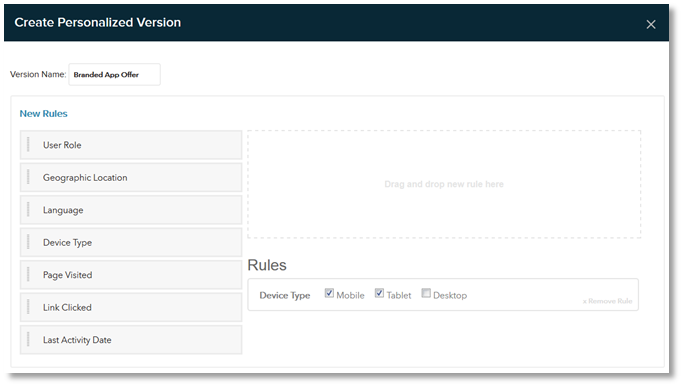
Easy. To do so, drag and drop the Device Type personalization rule, then select the devices to target (e.g. Mobile and Tablet). Next, use the Evoq page editor to insert the mobile app download offer in your personalized page.
OK, so let’s say your SaaS company is named Salesforce and you were using Evoq. You could create a personalization rule for this
Sales Cloud product page. Your personalized page for mobile visitors could include an offer to download the Salesforce1 mobile app.
Use Case 4: Use Past Activity to Offer Relevant Content
Let’s say you created a product feature sheet on content personalization, like
our Marketing team did here. Next, let’s say that some updates were applied to it.
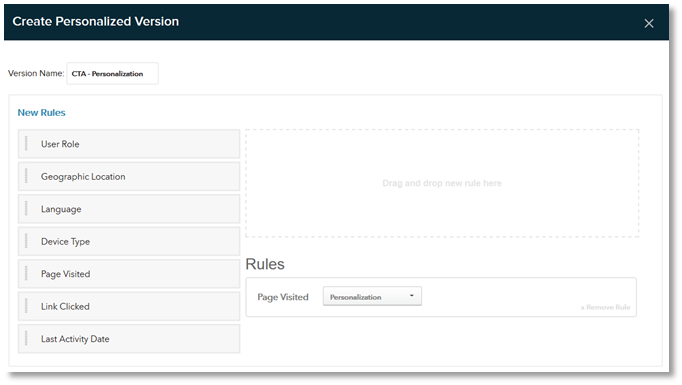
If you visited the personalization page in the past, then there’s a decent chance that you’ll want to know about the updated feature sheet. So you'd create a version of the personalization page for people who previously visited that page. On the personalized version, you'd offer the "UPDATED" feature sheet.
If you were visiting this site for the very first time, then an offer of the “UPDATED” personalization feature sheet is less relevant. But if you're a return visitor, you're saying to yourself, "Hey, DNN is making frequent updates to their product content."
And that’s the great thing about content personalization: you can use insights on past activity to offer related content to your visitors. And with Evoq’s content analytics, you can determine whether your offers are working. If the offers are falling flat, simply adjust your offers, see how visitors respond to them, then re-assess.
Use Case 5: Give a Refresher to Users Who Haven’t Visited in a While
I saved the most complex rule for last. Evoq’s personalization rules can be combined. When combined, all of the listed rules must apply in order for that personalized page to take effect. In this example, I’m looking at users who previously visited our
Integrations page and are currently on a mobile device.
In addition, their last activity date was last year. We’ve added new integrations since last year, so I want to bring this “old friend” up to speed on what’s new. So I could create a personalized page. On that page, I’d look for the integrations we added in 2015 (i.e. which were not in place when the user visited in 2014).
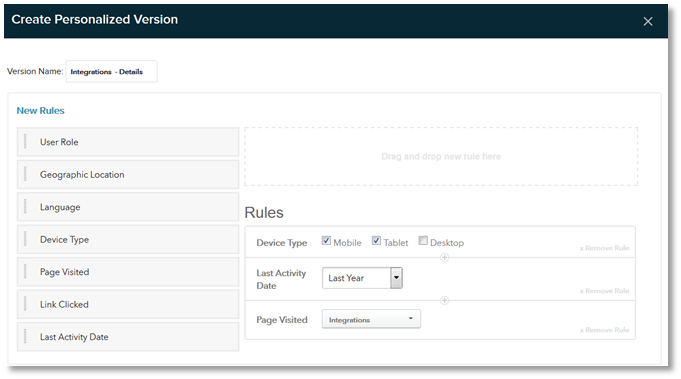
I could then insert text like “NEW!” next to each new integration, or use a more visual indicator to achieve the same effect. This particular user could quickly understand the new integrations added, while other, more recent visitors (or, brand new visitors) would not see these indicators.
Conclusion
Hopefully I’ve given you some ideas on how you can use content personalization to create a more valuable and compelling experience to your site visitors. Creating personalized rules and pages is a cinch with Evoq. And best of all, referrals from personalized pages are tracked in
Evoq’s content analytics. So you’ll be able to tell the specific personalized pages that are driving traffic to other pages on your site.
Evoq's Content Personalization: Try It For Yourself
Sign up for a
free trial of Evoq Content and see if you can set up some of the rules I've outlined in this blog post. Leave me a comment below to let me know how it went. Thanks!